Travertine pools, filled with mineral rich water cascade down the mountain side. This brilliant natural marvel has been a draw for visitors since ancient times. Used as a health resort by the likes of Cleopatra, today it is an Instagram favourite. Come with us as we visit Pamukkale’s Thermal Pools and the ancient cities of Hierapolis and Laodicea.
Pamukkale Thermal Pools
Nicknamed ‘Cotton Castle’, Pamukkale’s white, travertine thermal pools cover the mountain in a blanket of white. These pools, filled with beautiful blue water, gave the mountain an even more magical appearance. At least that’s how they used to be seen. Today, the thermal pools of Pamukkale are dry, but this unique display of nature’s artwork is still an awe-inspiring vision.
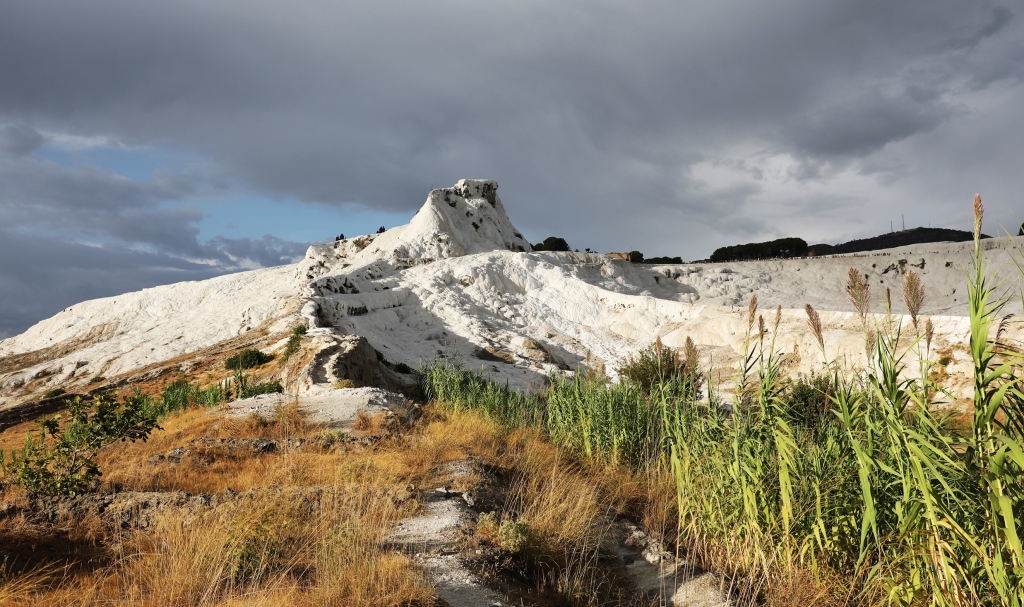
The pools were formed centuries ago by underground thermal springs that escaped through fissures in this earthquake prone area. This process is still occurring, although on a much smaller level. The water is high in calcium, bicarbonate and other minerals. Once the water reaches the ground it cools and carbon dioxide is released. The result is a calcium carbonate precipitate and once that dries, it becomes travertine. In addition to fissures, earthquakes have caused the hill to be uneven, allowing the travertine to form pools in the flatter areas. The water slowly trickles down the hill making travertine pools at different levels, covering the slope in white. As long as the mineral-rich water flows, the travertine pools will grow.
Unfortunately for us, the travertine pools of Pamukkale were quite disappointing. Almost all of the pools are dry, leaving only stark white pools filled with clay. They are not as you see on social media or marketing brochures that show a mountain covered in turquoise pools rimmed by white edges. They were once like this but not any longer. We were told two stories for this lack of water. One is that the pools were purposely drained to allow the travertine to whiten. The second explanation is that because of the increasing water needs in the growing cities below, there is not enough water to fill the pools. Perhaps it’s a combination if the two.
We began our exploration of Pamukkale from the lower gate at the bottom of the hill. After removing our shoes we walked up to the top passing a row of eight man-made pools. These pools are apparently the only pools that are always filled with water. They are also the only ones that you are allowed to enter. The man-made pools are unique and beautiful, but not as picturesque as we had hoped.
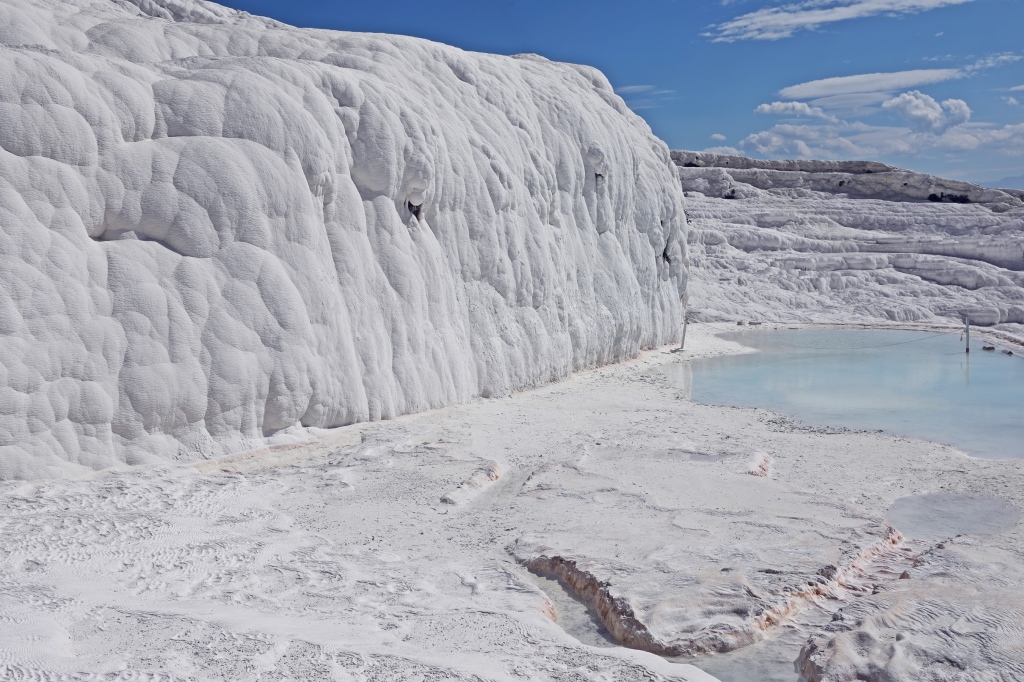
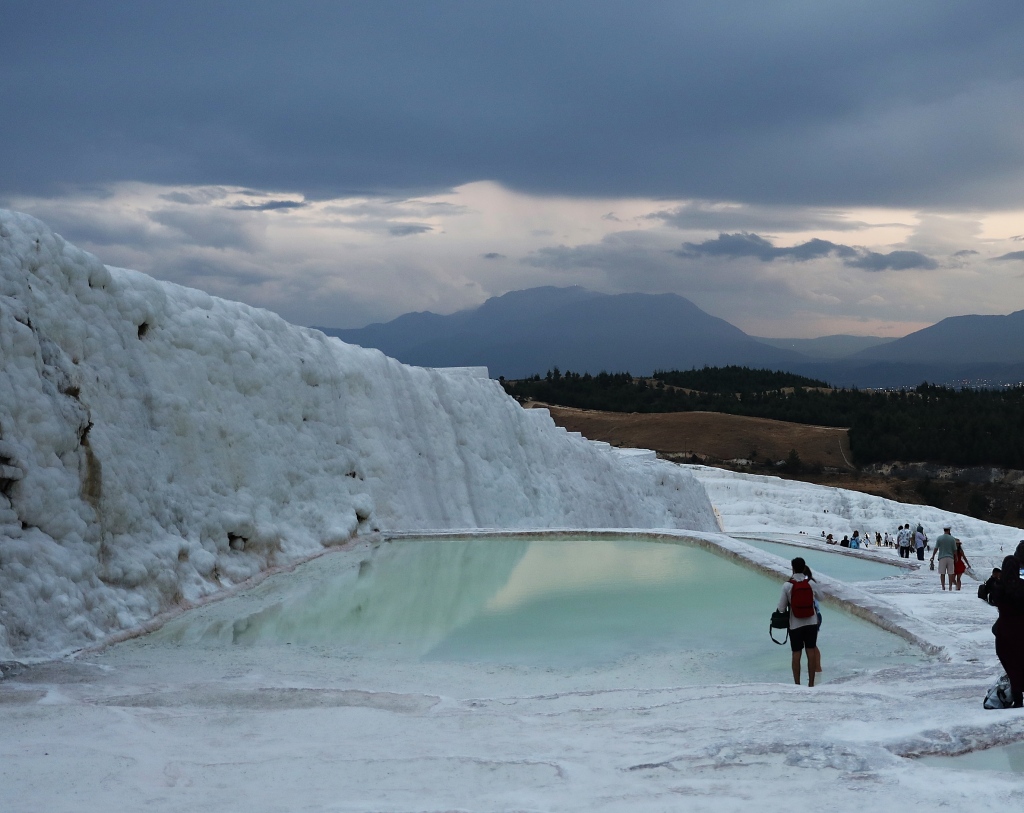
We read that Pamukkale is the most visited tourist site in all of Turkey. You can imagine then how many people are trying to get that perfect shot of the pools. The crazy thing though, is that since tour buses arrive at the upper gates, only the top few pools are busy. Only a few of the throngs of people made it down to the bottom 3 or 4 pools, so these are often empty. This Instagram hotspot had people dressed in all sorts of crazy outfits, making annoying poses and hogging the top pools. We couldn’t wait to get away from this busy part of the park.
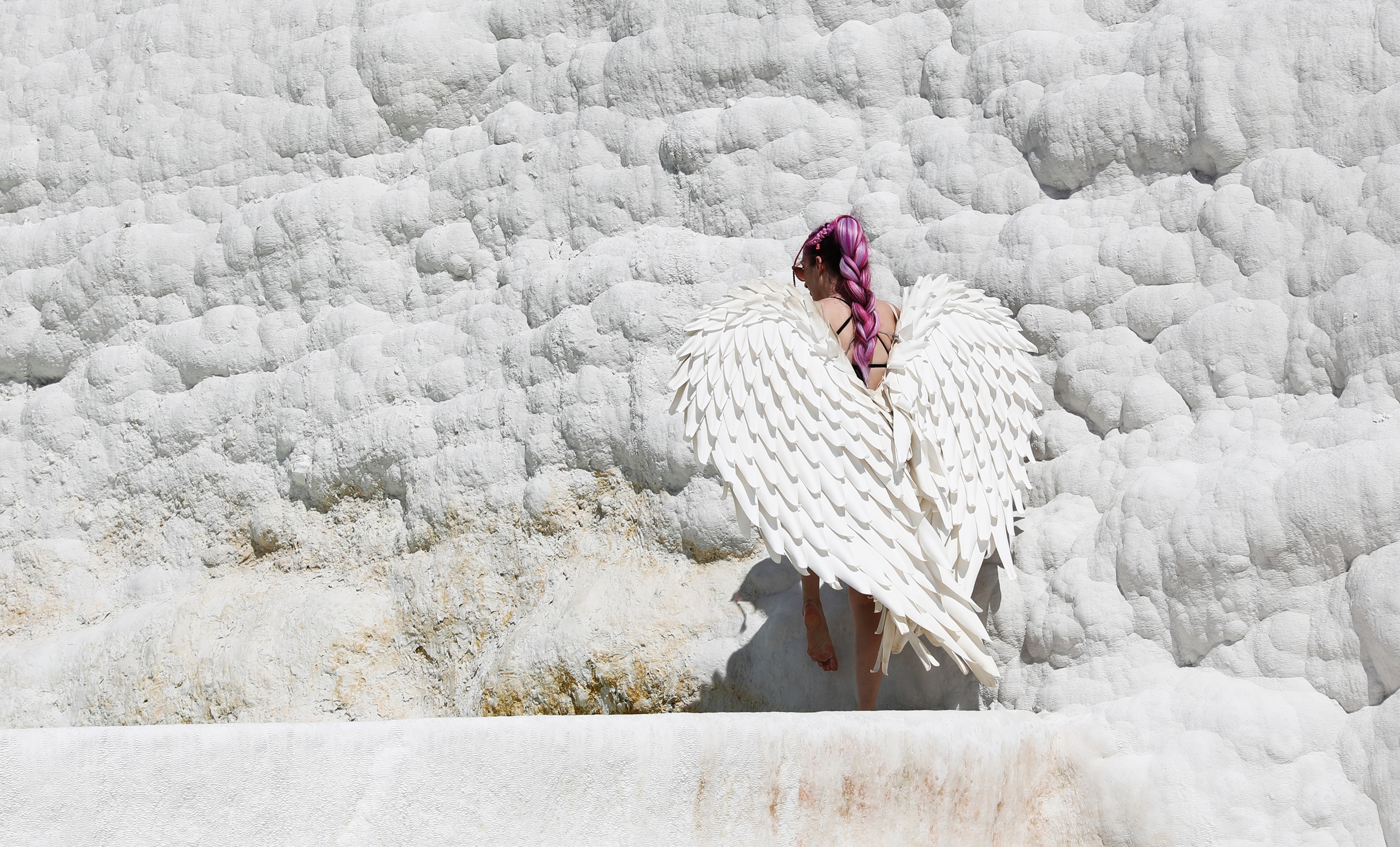
Tip – These 8 pools are in the shade until noon so even though it is quieter first thing in the morning, the pictures won’t turn out because there’s not enough light.
As we walked up the hill beside the man-made pools we looked to the other side of the walkway where there are hundreds of white, travertine pools. Since they are all white, they’re not nearly as picturesque as we had hoped.
Sidewalks along the top of the hill allow you to look down on the mountain. From there we continued to see hundreds of these dry, white pools. Some were stark white, others had a layer of mud on the bottom. This scene does bring about a sense of awe though, at how spectacular nature’s designs can be.
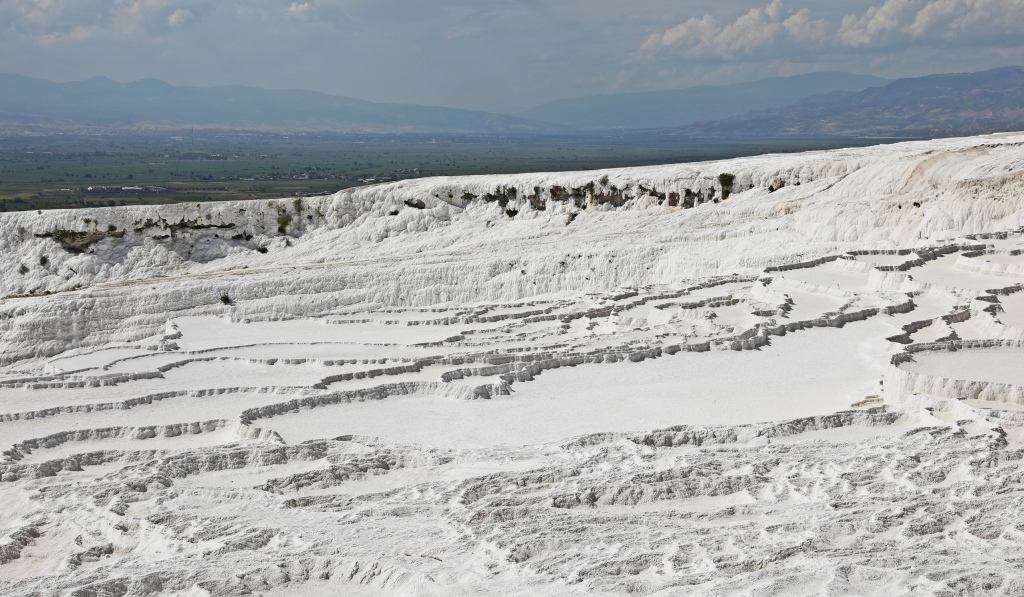
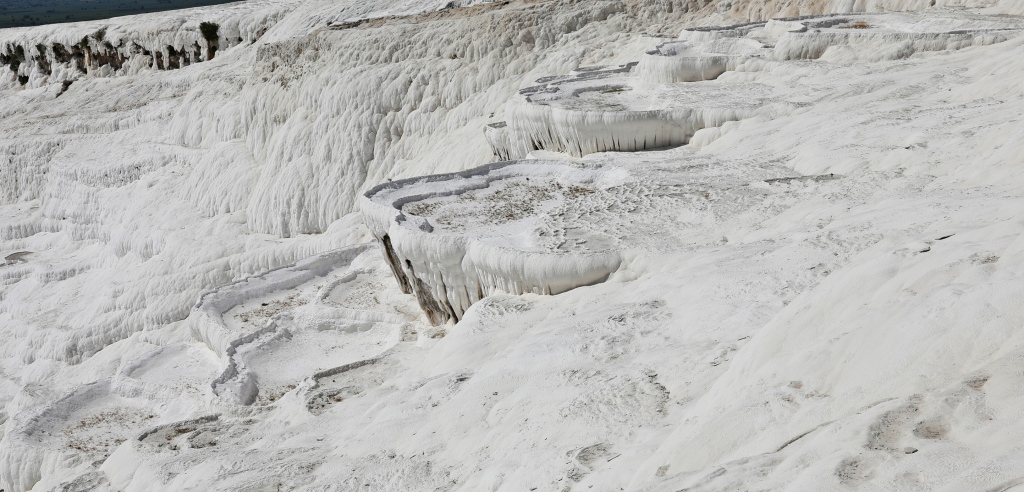
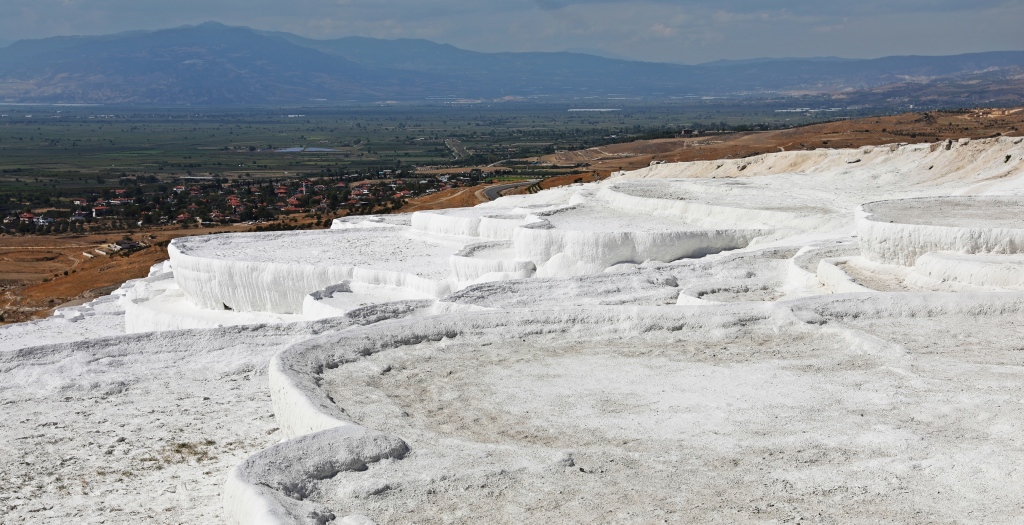
After walking along the top for a while we were lucky enough to stumble on a small group of natural pools that were filled with water. No one else seemed to know about these pools and we had them almost all to ourselves. This small collection of pools finally gave us an idea of how spectacular this area must have been in the days of Cleopatra.
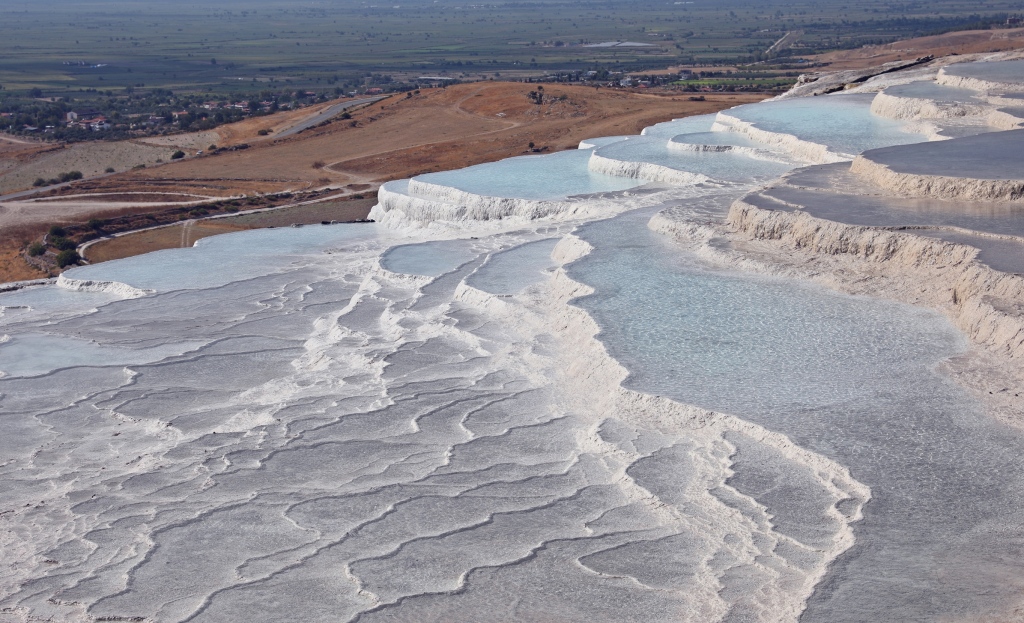
We returned to this spot at sunset where we were able to see what all of the hype was about. The white-rimmed pools, reflecting the orange setting sun, created a phenomenal view. If only the entire mountain was still this beautiful.

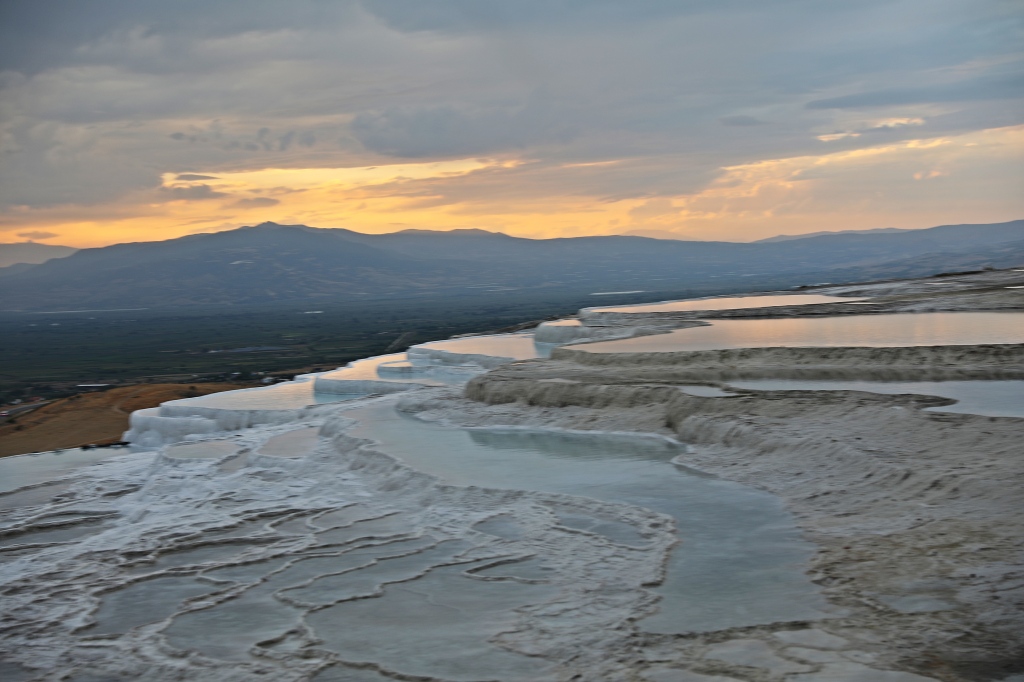
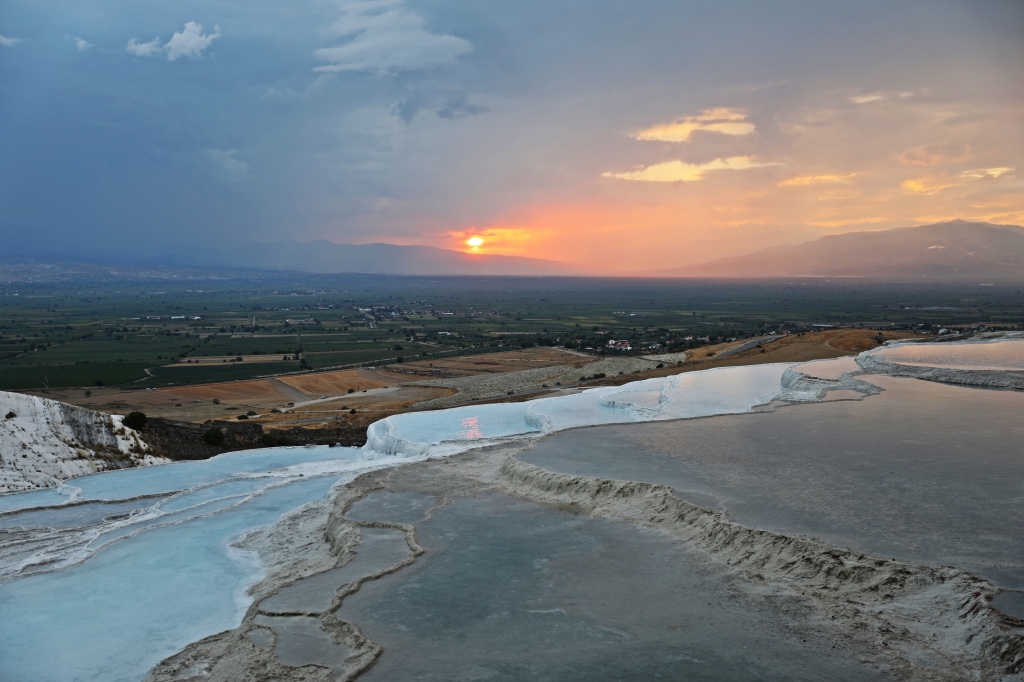

We can’t deny that Pamukkale is an unmatched natural beauty, but it is not as advertised.
Hierapolis
The Greeks soaked in the travertine pools as early as the 2nd century BCE. As the pools became more popular, the spa-resort city of Hierapolis was built on the flats above.
Today, most of the city is in ruins, but there are a few sites that make it worth exploring, beginning with the main entrance to the city. The 1st century triple-arched, travertine Domitian Gate would have given a stunning first impression. Named after the Emperor Domitian, the gate leads you to Frontinus Street which would have been one of the city’s main markets.
During his reign Emperor Domitian declared himself to be god so those that enter the gate had to pledge devotion to him.

In the middle of the city, the 3rd century Apollo Temple, was under renovation when we visited. It will likely be a gorgeous building when its completed. What is hiding beside the temple is more interesting anyway. The Plutonium, likely from the 2nd century BCE, is dedicated to the God Pluto who presides over the afterlife.
The Plutonium was built atop a cave that emits a suffocating CO2 gas, which they believed was sent by Pluto. It is thought that ancient rites, such as sacrificing bulls, were performed here. The animals were sent into the cave and suffocated to death from C02 poisoning. Strangely, eunuch priests were the only ones who weren’t affected by the noxious gas. Likely they learned that they could hold their breath while venturing inside and make it out alive. Because of their tricks, the eunuchs were held in high esteem and were considered to be Oracles.
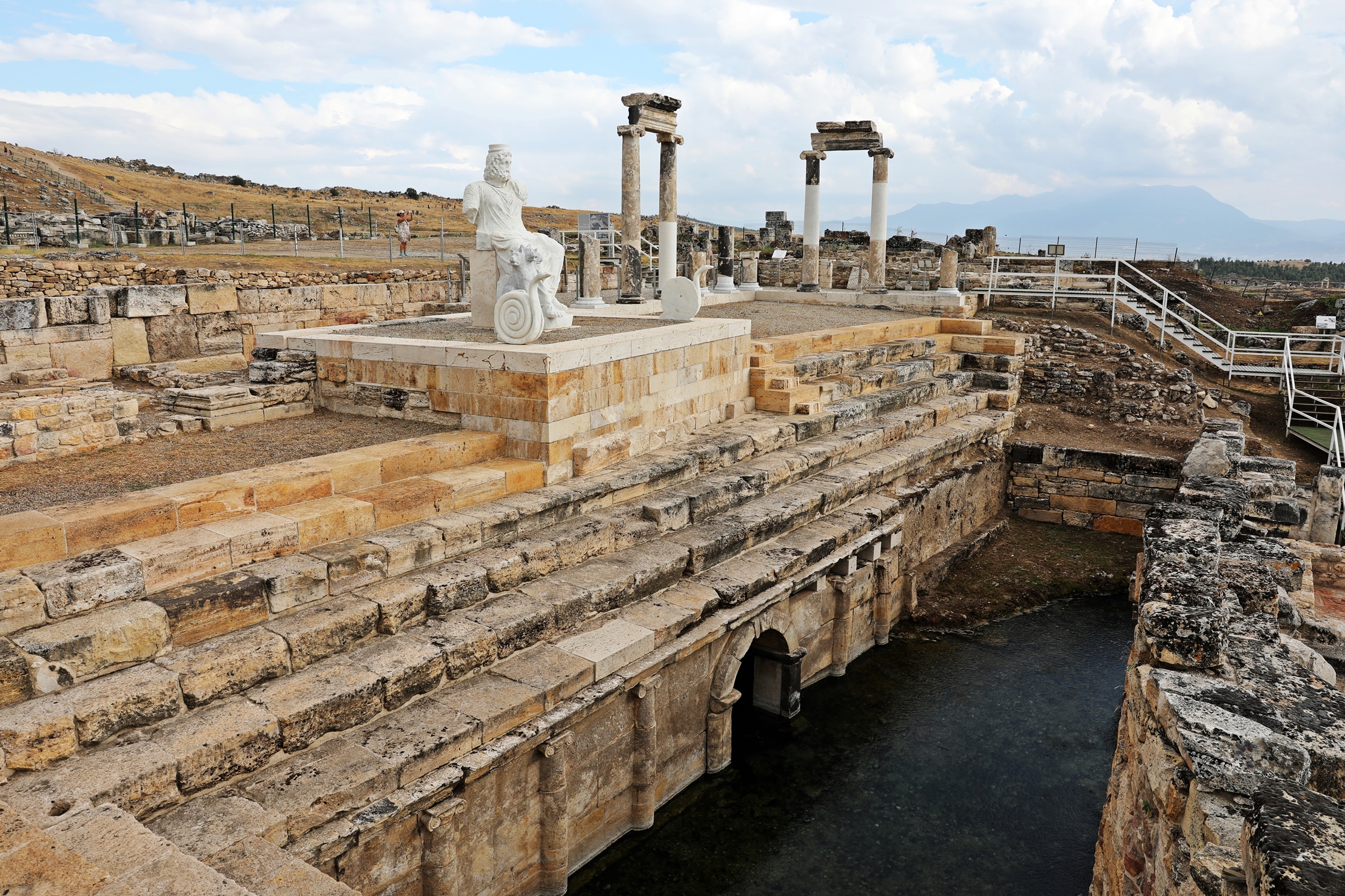
Above the temple is the theatre. Having seen so many Greek and Roman theatres, such as Ephesus, we weren’t really sure we needed to see another, but we’re so glad we did. At the front of the 3rd century AD building are gorgeous marble columns and elegantly sculpted friezes. It has been restored, allowing us to get a better sense of its original beauty. This piece of art provides an incredible backdrop to the large theatre.


In the 5th century, the orchestra pit was lined with waterproof mortar. Pipes were added so the pit could be filled with water. This allowed for water themed performances and made us wonder if this was the inspiration for Cirque du Soleil’s show O.
In the 1st century citizens worshipped their Emperor as a god. At this time, St. Philip, one of the disciples, preached Christianity to the people. Because of this, Emperor Domitian had him crucified. There is a martyrium and tomb that may have been Philip’s, but much of it is in ruin. Over three hundred years later the city became Christian under the Byzantines.
At the far end of the city is a massive necropolis. The shear number of sarcophagi, tombs and tumuli (funery chambers) led researchers to believe that Pamukkale’s mineral pools were used for their healing properties. They believe that many people came to cure their various illnesses. Likely though most were not cured by the pools and instead died here. The necropolis covered a large area that extended all the way to the pools. We found one tomb inside a travertine pool.
There are so many sarcophagi here that some researches talk about the 4th and 5th centuries’ sarcophagi industry. Funny how we don’t tend to think about organized industries in these times.
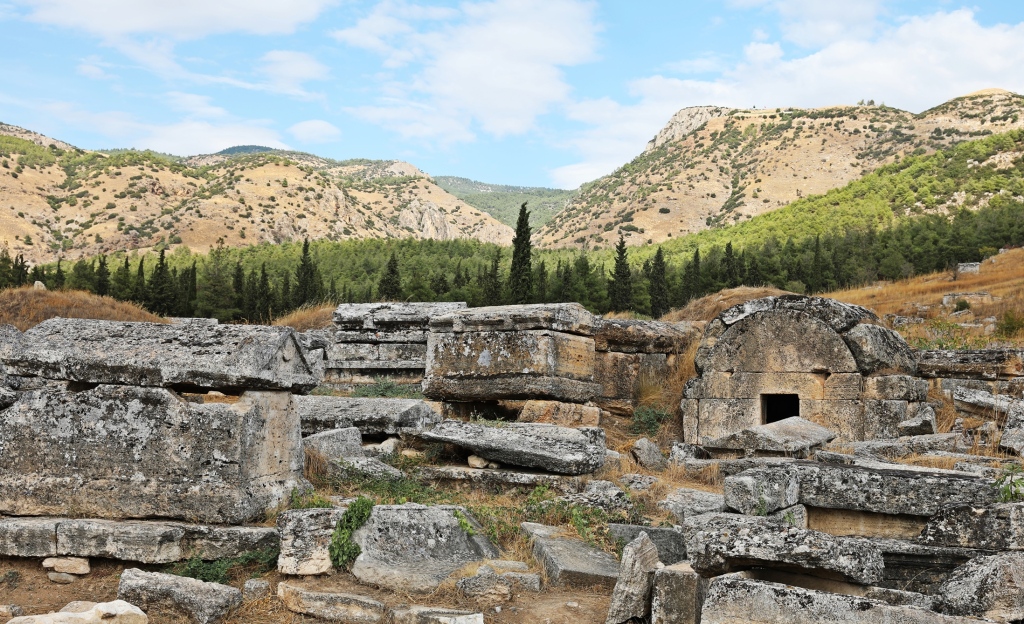
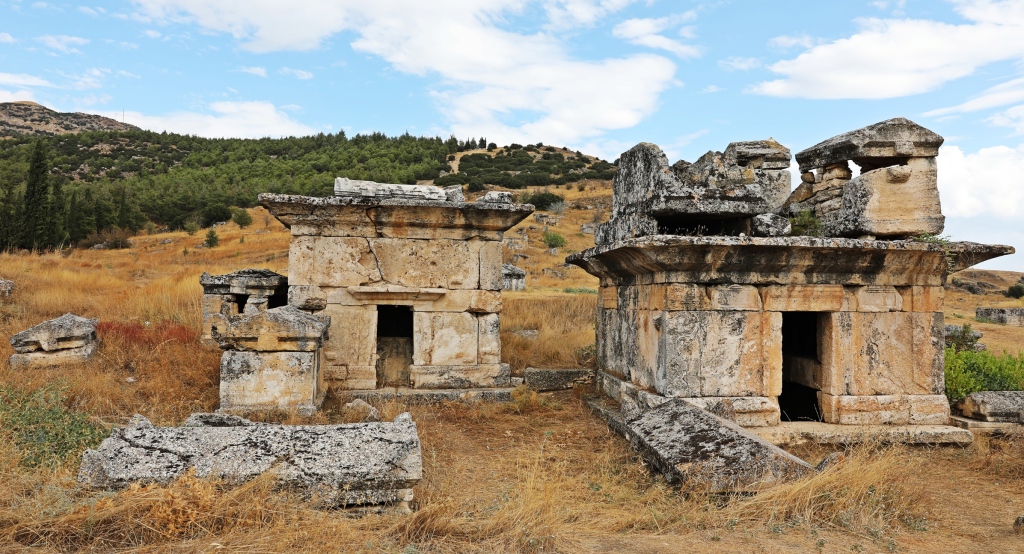
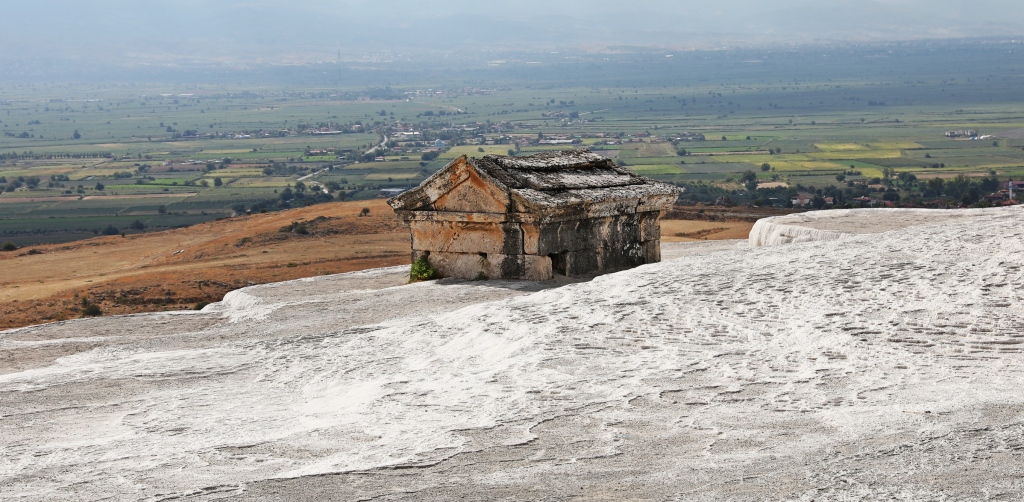
Inside the museum there are a few examples of how elaborate these sarcophagi were.

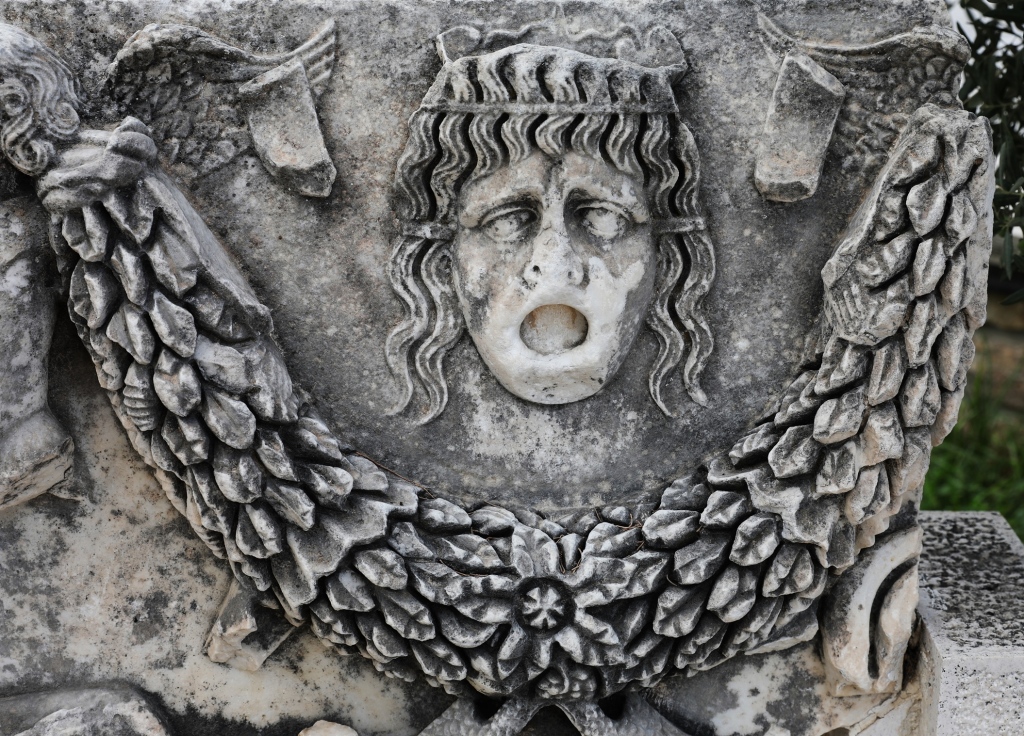
Next to the museum is the information centre and Antique Pool apparently used by Cleopatra. Columns from the original bathhouse are still at the bottom of the pool and for a fee, you can swim over them. The pool was quite busy and since we had already swam over ruins in Kekova, we didn’t feel the need to do it here.
Pamukkale Town
At the base of the travertine pools is the small town of Pamukkale. Even though the pools were very busy, the town was quiet. It seems that most people take day tours and don’t stay locally.
From the edge of town you can see the tall white mountain hovering above a small duck pond. Running from it are canals lined with travertine. Further down, a man-made set of pools are on display. They are actually nicer than the man-made ones on the hill.
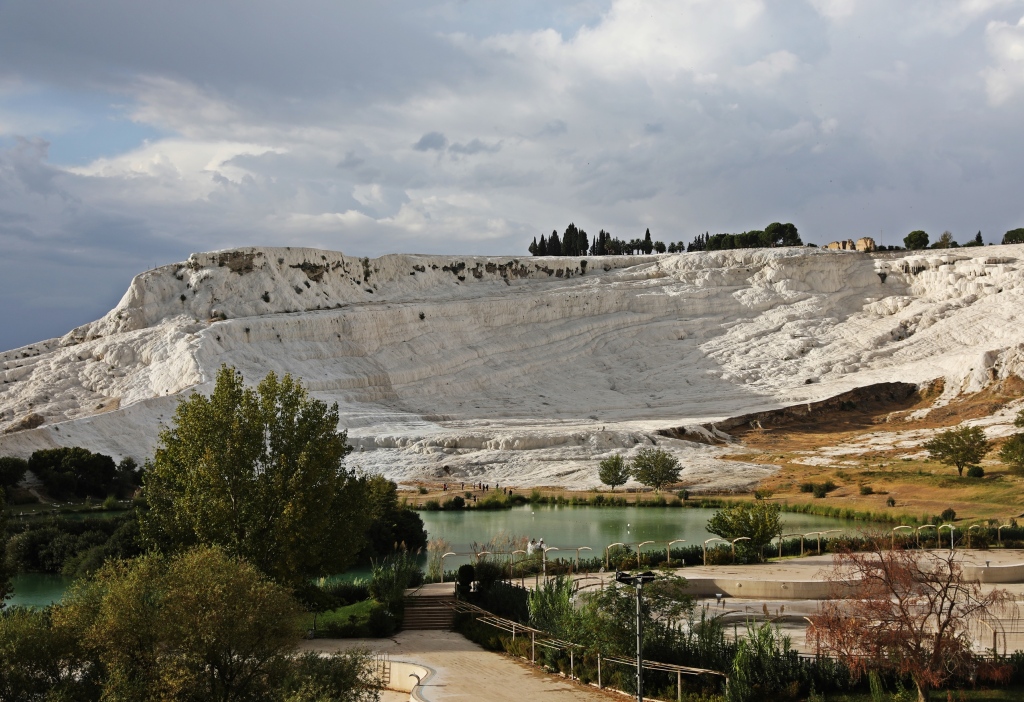
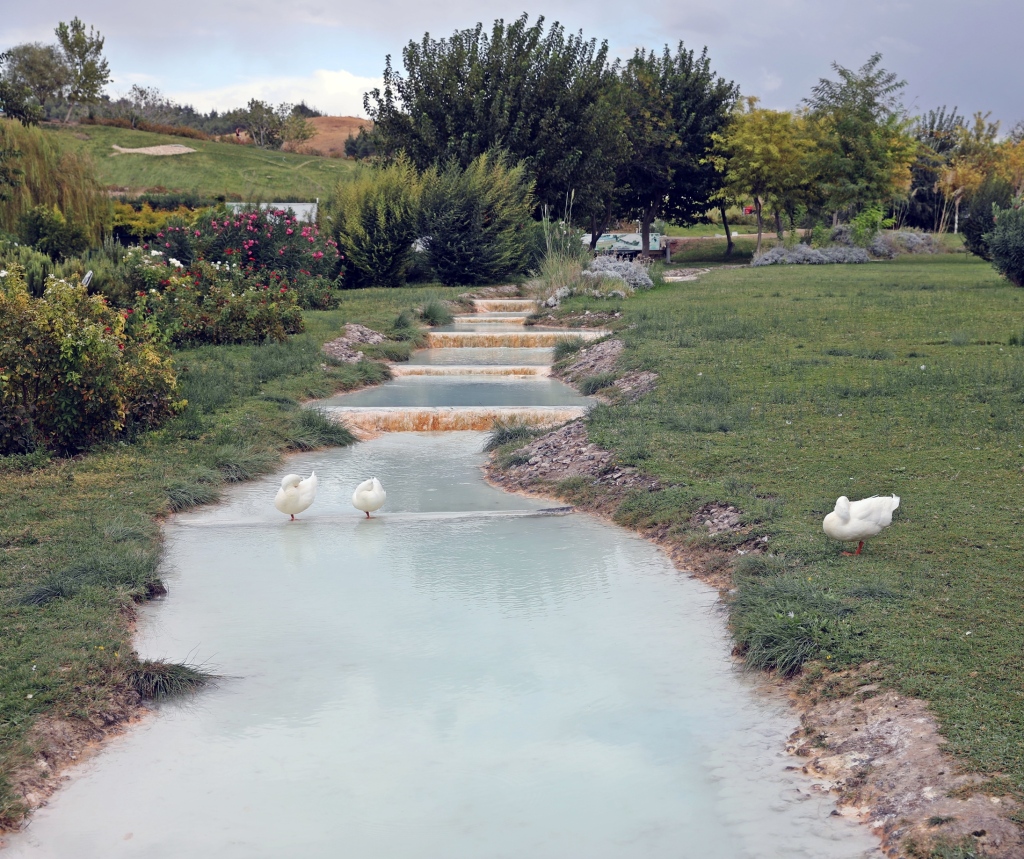

Laodicea
On the top of a hill on the other side of the valley from Pamukkale is another site with Greek and Roman ruins. From the tall columns of Laodicea we could see the white travertine-covered hill of Pamukkale in the distance.
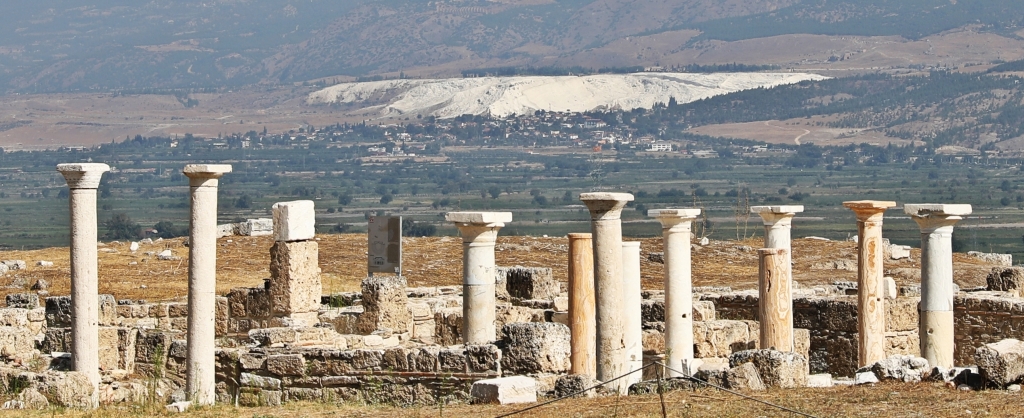

The most interesting building in the ancient city is the Church of Laodicea. The floors of this large 4th century building are covered in gorgeous tile mosaics with images of old clerics and geometric designs.
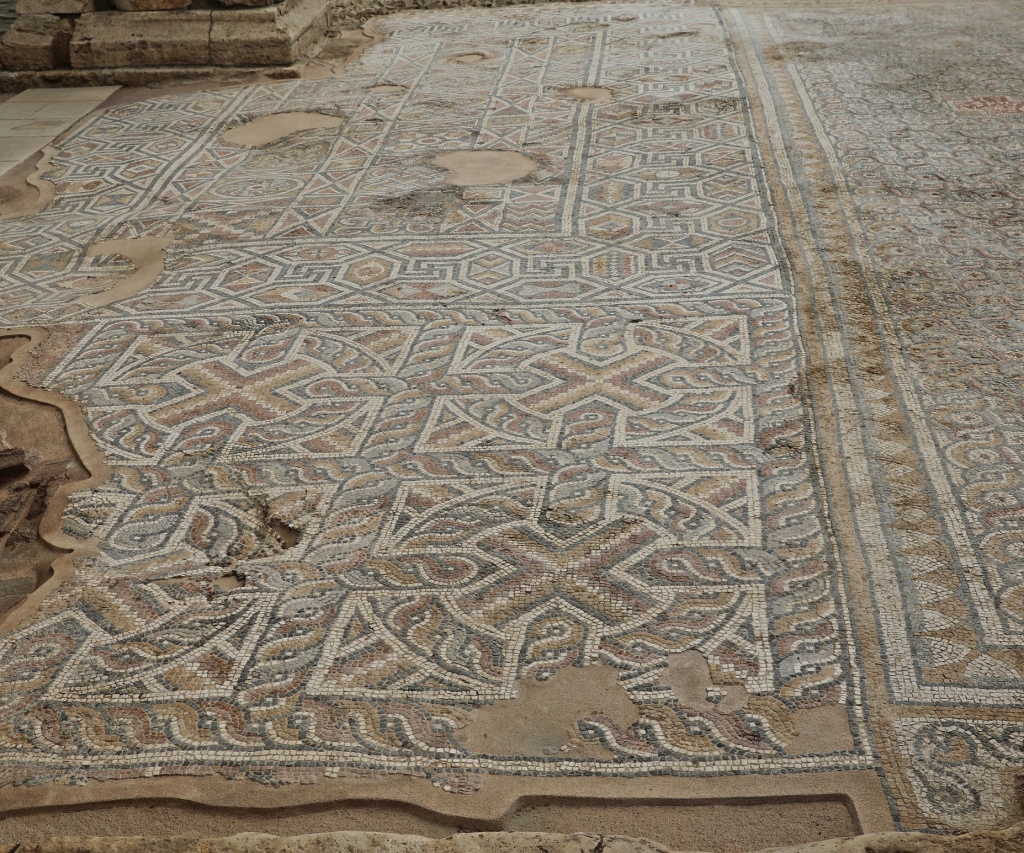
Next door to the church are the remains of a temple. Above the columns, beautifully carved friezes provide great examples of the skill of the carvers.
At the back of the temple, a glass floor allows you to walk over one of the rooms. Although today the room is deep underground, it would not have been when it was built. Walking above it brings perspective to how much earth has covered these buildings over the centuries. It was an interesting way to view the ruins, but not easy to photograph.

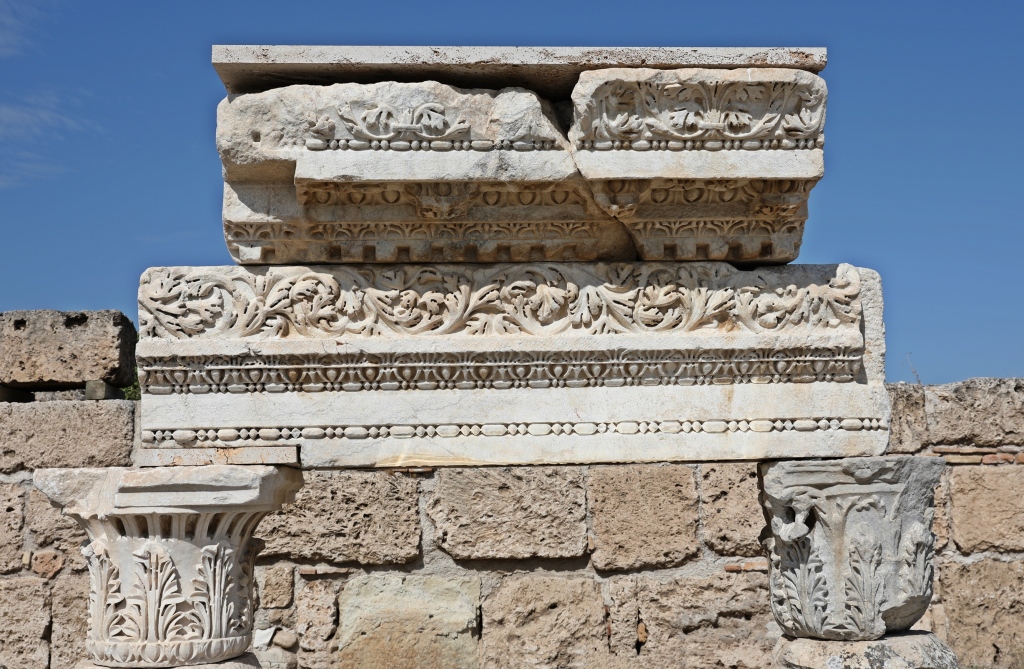
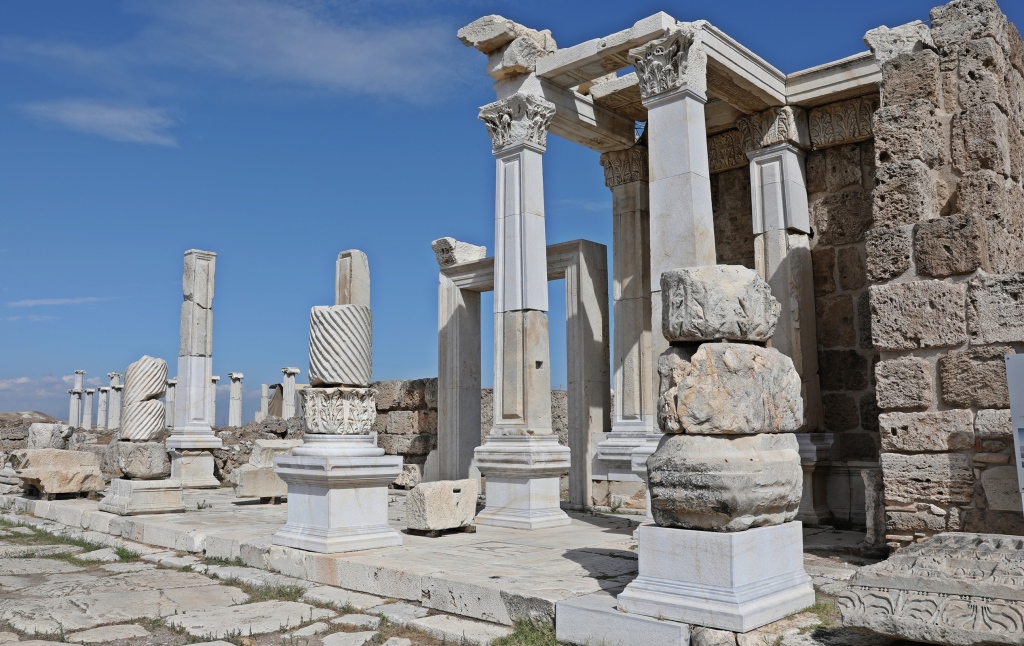
Tips for Visiting Pamukkale
Loaded tour buses start arriving around 9 am and continue to arrive until 5 pm. They seem to stay at the top 2 or 3 pools and only visit a couple of archaeological sites so it wasn’t as bad as we expected.
Instead of taking a tour, consider staying in the small town of Pamukkale. There are several local hotels and restaurants within walking distance of the site.
Entrance Fee – Pamukkale/Hierapolis 700 TRY ($22.80 USD); Ladoacia 280 TRY ($9.20 USD), Combined ticket for all three was 850 TRY ($27.70 USD); Opening Hours – 6:30 am to 9pm
Tip – There are many different museum passes in Turkey that provide discounted fees for multiple sites in a short period of time. For us they often included sites we were not interested in seeing, so it was usually cheaper to buy individual tickets. You can find pricing on the government website here.

To read more of our adventures from Turkey click here.
Coming Next – Izmir & Pergamon
For pictures from other blogs go to Gallery at monkeystale.ca
To read about more of our adventures go to Destinations.
If you like what you read, please comment or share (with credit) using the links below.
Wonderful pictures and write-up, Maggie!
LikeLiked by 2 people
Thank you Indira! Maggie
LikeLiked by 1 person
I had to do a double-take with the Plutonium. I checked the etymology of the radioactive chemical but could find no link to the earthly geological site–only to the Planet Pluto. Also, it’s interesting that there were Oracles who were not affiliated with Delphi. This part of the world is quite fascinating.
LikeLiked by 2 people
I think the planet was also named after the god, so in a round about way the chemical was too! There were other Oracles in Greek and Roman history, but none as famous as Delphi.
LikeLiked by 1 person
I still remember the first time I saw Pamukkale, Turkey’s famous white “cotton castle” in person – I was in awe of its collection of bright blue pools of water amongst a pristine, all-white landscape. I admit I’ve occasionally visited world-famous sites that were a tad… underwhelming. It’s not necessarily due to the site so much as to how I’ve built the experience up in my head. Sometimes after seeing hundreds of photos and videos of a destination, I unintentionally create these unrealistic expectations of what it will look like. Of course, I’m inevitably disappointed. I was worried that Pamukkale would be a victim of the images online. Thankfully, that wasn’t the case. Pamukkale in real life was everything I imagined and more. I completely understand why it’s Turkey’s most popular attraction.
LikeLiked by 2 people
You must have visited a while ago? Today there are very few pools with water.
LikeLiked by 1 person
O my goodness, is that true? I was there in 2007, and the pools were everywhere. Things must have changed
LikeLiked by 1 person
There were only the 8 man made pools and a small group of about 10 that were far off the main group of pools. The rest are dry 😦
LikeLiked by 1 person
😳😳😳
LikeLike
That. is a bummer that the pools weren’t as advertised, but glad you had the sunset experience! I can imagine it being overrun with the Instagram crowd. I’d enjoy visiting Hierapolis.
LikeLiked by 2 people
I’m so glad we found the small area of pools, and it was far enough away that no one else found it! Hierapolis is a great site, with different buildings and stories than the other ruins we’d been to. Thanks Lyssy, Maggie
LikeLike
Wonderful pictures, i really would like to see these poles.
LikeLiked by 2 people
Thank you, If you don’t expect the mountain to be covered in them, its a nice site. Thanks for your comment 🙂 Maggie
LikeLiked by 1 person
What a wonderful and incredibly historic place! Did you just walk around the pools or did you try to take a dip in the first ones? We just visited some unique geothermal pools on the Azores (Portuguese islands). Surprisingly (thankfully) we did not encounter throngs of tourists creating content for social media. Amazing how IG has changed the vibe of some places. Great post!
LikeLiked by 2 people
Thanks, we walked through the bottom few as well as the ones in town, but it’s only ankle deep water and not the environment to sit and have a soak. IG really has changed how many people visit some of these places and how they act. It’s too bad, but this is the new reality I guess. Thanks for sharing your thoughts! Maggie
LikeLiked by 1 person
Great pics and details as usual.
LikeLiked by 2 people
Thanks!!
LikeLike
Such a fabulous post! I have wonderful memories for that indescribable place
LikeLiked by 2 people
Thanks Luisa, I bet it was nicer a few years ago when you visited. Maggie
LikeLiked by 1 person
It was wonderful!
A truly unforgettable experience⭐⭐⭐⭐⭐
LikeLiked by 1 person
That’s always a bummer when something is not as advertised. Having never seen it before, though, and having no expectations, I find your photos very pretty! It reminds me a bit of parts of Yellowstone. Plus, it looks like all those ruins make Pamukkale worth the stop.
LikeLiked by 2 people
It was about as busy as Yellowstone 🙂 It is a pretty place, but high expectations can lead to disappointment I guess. The ruins were great to see and had a few interesting details that weren’t at the other cities. Thanks Diana! How’s the carpal tunnel?? Maggie
LikeLiked by 1 person
Slowly getting better, but I’m still somewhat limited in what I can tolerate. I was finally able to finish a post, though!
LikeLiked by 1 person
Yay!!
LikeLike
Looks like they cleaned them up. They became very polluted not that long ago due to excessive tourism and were closed to visitors. We were lucky to visit before that time and were able to lie in the hot pools with very few people around. And there was no entrance fee!
LikeLiked by 2 people
Lucky you!! They had more water a few years years ago, but not anymore. I can’t blame them for letting the pools whiten, but their advertising pictures are from years ago so they set up the wrong expectation. Plus it is very expensive now by Turkish standards.
LikeLiked by 1 person
Sad! There were so many beautiful places to visit in the past that have been ruined by excessive tourists and tourism in the meantime.
LikeLiked by 2 people
yep, very sad.
LikeLike
Instagram has a lot to answer for! This reminds me of the crowds we saw queuing to take selfies in front of the ‘Tomb Raider tree’ at Angkor Thom when there were loads of very similar, and just as photogenic, trees a few metres into the site and nobody near them! It pays to take your time and watch where the Insta crowds don’t bother to go! A shame though that the pools even then didn’t quite live up to your expectations.
LikeLiked by 1 person
Glad we saw Angkor Wat before IG. That’s true, go opposite to the crowds! I think what bothered us more was the museum’s advertising showed pictures from a few years ago when there was water, plus they just increased the entrance fee.
LikeLiked by 1 person
Yes, that is naughty!
LikeLiked by 2 people
I don’t know where to begin because all the photos are so beautiful. I especially loved the mosaic floor.
LikeLiked by 1 person
Thanks Kymber, the mosaic tiling in these ancient buildings blows me away. I’d love to have it in my house 🙂 Maggie
LikeLike
Hopefully, you didn’t experience anything similar to snow blindness after touring the beautiful-and brilliantly white-Pamukkale Thermal Pools! Great post!
LikeLiked by 1 person
All the theatre-goers at the pool again, I see 😉
But like, wowsers, I can see why those pools would be a draw!
-✧✦☆❖◈❋✤☆✦-∞-♡-∞-✦☆✤❋◈❖☆✦✧-
LikeLiked by 2 people
Ha yes, who knew theatre lovers also love thermal pools! I guess we can’t blame others for being there, since were we, there too but they all seem to congregate in one area, and wear hilarious outfits 🙂
LikeLiked by 1 person
whoa! what? wait, stop. so you tellin me you were NOT kitted out in a ya insta-tastic costume?
LikeLiked by 1 person
Hahaha, sorry that wasn’t me with the wings!
LikeLiked by 1 person
oh goshdarnit. oh well, never mind. next time maybe. 🤣
LikeLiked by 1 person
Hello. Good article. It got me thinking: I think that many ancient cultures weren’t all that different from ours. It’s electricity that made possible the “modern” world. But nobody had electricity till the late 1800s.
LikeLiked by 2 people
Good point, they were able to build amazing architecture, soak in hot tubs, go to the theatre and watch sports in arenas. And all without electricity. It’s quite impressive to see what they built in ancient times. Thanks for sharing your thoughts, Maggie
LikeLiked by 1 person
I remember visiting Lower Antelope Canyon hoping for a serene walk through a smooth gold sandstone slot canyon with shafts of sunlight highlighting the curves and layers like the pictures I had seen. Instead we were hustled through in groups of ten about a minute apart by a guide who clearly didn’t want to be there with no stopping allowed and hardly a chance to get a picture without anybody else in it! Making money was the name of the game sadly
LikeLiked by 2 people
It’s always so disappointing isn’t it. I have seen those great pictures of Antelope Canyon, too bad it wasn’t as advertised either.
LikeLiked by 1 person
Thank you for the incredible journey to these historic sites. Pamukkale looks amazing despite the change in water levels, the few pools that you did find looked like something out of a movie…pretty cool. I see that taking photos dressed in angel wings at Pamukkale as an Instagram shoot is a thing. There seem to be quite a few images of that kind floating around on the Internet…fascinating!
The remains of the church in Laodicea are amazing.. the columns and sculptures on the tombs are so intricate. I agree the carvers had some spectacular skillsets. Great sharing as always. I enjoyed the duck pond too!!
LikeLiked by 1 person
Thanks Suzette! Instagram brings out the crazy I think 🙂 Overall it was a great stop, just not what we thought it would be. 🙂
LikeLiked by 1 person
I think it Instagram does…LOL.
A dream journey nontheless, I think, how awesome it is to visit places mentioned in the scriptures.
LikeLike
It’s true that the pools have been seen many times on Instagram, but you managed to find different sights.
LikeLiked by 2 people
The archeological sites were quite good, and each offered something different so in the end it was worth the trip.
LikeLiked by 1 person
Your photos show a beautiful unique place.
They should use your more up to date photos to advertise. Then there would be no disappointment. 🙂
LikeLiked by 2 people
Haha thanks! Yes they should 😊
LikeLiked by 1 person
Your sunset photos are particularly beautiful. It’s unfortunate that it’s now not as advertised. I visited before issues came up that closed the pools – far too many people, for one. The ruins in that area are interesting, however. Great post.
LikeLiked by 2 people
Thanks Lynette, I would have loved to see it a few years ago. Maybe they’ll fill them again someday.
LikeLiked by 1 person
Turkey just keeps on giving, doesn’t it? That landscape is surreal, even if it doesn’t sparkle with water as it once did. You found a way though, Maggie, and I applaud you for that. Those sunset shots are magical, and Hierapolis looks a magnificent site.
LikeLiked by 2 people
Almost every site in Turkey was better than the last! I was quite stubborn with this one and wouldn’t give up until I found some water 🙂
LikeLike
🤣🩵
LikeLike
I’m travelling virtually with you (and finding it remarkably easy) and was not disappointed in Pamukkale, having never known of its existence, but I felt your disappointment. Your photos are beautiful and I’m glad you captured the pools that you did. No one swims in them? The artwork is marvellous once more – forgive me for any lapse of memory, but you haven’t seen much Turkish designs in recent posts/towns? My history is pretty limited so I’m assuming the Romans dominated that aspect?
LikeLiked by 2 people
The eastern side of Turkey has more of what we think of as Turkish, but we actually didn’t find as much of that as we thought. There are a lot of Greek/Roman/Byzantine influences in this western area. You’ll maybe see a bit more in the next city, Izmir. And no one baths in the pools, the water is only ankle deep.
LikeLike
Lovely! X
LikeLiked by 2 people
Thanks!!
LikeLike
I’m so glad I visited when insta-tourism was just beginning. It was annoying already, but not as much as it would be today. Interestingly, we had Hierapoilis almost completely to ourselves.
LikeLiked by 2 people
There weren’t many people in Hierapolis, just at the theatre and Cleopatra’s Pool! And the only at the top of Pamukkale. So we did have the rest to explore on our own. But there were hundreds clumped together in those spots. Here and Ephesus were very busy but there weren’t many tourists in the rest of Turkey. Thanks for following along, Maggie
LikeLiked by 1 person
I had no idea how fabulous Turkey is, Maggie. Thank you for bringing it home with you through your photos and words. Absolutely incredible.
LikeLiked by 2 people
We were so surprised by the incredible sites in Turkey too. Glad to share it with you! Thanks Mary! Maggie
LikeLike
Amazing photos!
LikeLiked by 2 people
Thanks Donna! Maggie
LikeLiked by 1 person
Amazing photos and write up of the pools and ruins. The pools are quite otherworldly. Too bad about the tourists interested only in selfies. Like you I find them very annoying.
LikeLiked by 2 people
At least th selfie takers kept to one spot 😊
LikeLiked by 1 person
Those Pamukkale pools are beautiful! I say you got the perfect shots!
LikeLiked by 2 people
Thanks Janice!! Maggie
LikeLiked by 1 person
We seem to have had very different experiences here, Maggie. We too stayed in Pamukkale and also visited these places, and visited the town of Denizli and the site of Aphrodisia. But the cotton castle was again like Ephesus pretty much deserted (as it was COVID times) and there were no coach parties. We walked from town and climbed from foot to top so were free to explore the travertine areas and Hierapolis – and were able to bathe in the pools and lay in the cascading streams. It sounds as if there was considerably less water present when you were there – I wonder if there has been significant change in those few years or maybe it changes seasonally? We felt very sorry for the traders in Pamukkale, they were pretty desperate during COVID with so few visitors.
LikeLiked by 2 people
We were told there hasn’t been water for a couple of years, so I’m not sure how long its been that dry. To add to it the prices had just gone up dramatically.The town itself was quiet too, and we also felt bad for the shops and restaurants, since the thousands of people who came didn’t stop. It was good, but not as great as many other places we visited in Turkey. Can’t win them all 😊
LikeLiked by 1 person
Well how interesting. It was October 2020 we were there so it’s possible there’s been that much change in such a short period – amazing! It was also pomegranate harvesting time which made for some interesting rural sights too.
LikeLiked by 1 person
Lucky you!!
LikeLiked by 1 person
Instagram Angel: almost as shallow as the pools themselves! (Sorry – don’t get me started on Instagrammers. They make me crazy.)
Beautiful ruins and such interesting stories. Oh, those poor sacrificed bulls!
LikeLiked by 2 people
🤣🤣🤣 I’m glad the IGers didn’t make it over to our secret spot!
LikeLiked by 1 person
Sorry to hear that the thermal pools were a bit of a let down. I never understood those people who just care about taking selfies of themselves rather than the landscape. Don’t even get me started on the people that dress up in crazy outfits. I’d be annoyed too. Glad you found some pools that were filled with water and were super secret so you had them all to yourselves.
LikeLiked by 2 people
I’m glad we found those remote pools, otherwise I would have been very upset. And very glad there were no selfish takers there. 😊
LikeLiked by 1 person
Fascinating place. I cannot believe the Instagrammers of the travertine pools. Whilst I do love a bit of an Insta shot, the thought of going to this length and dressing up and getting in people’s way – absolutely ridiculous. I remember going on a walk in The Cotswolds here in the UK and crossing a famous insta spot in my hiking gear….there was a queue to get over the bridge of around 25 women in dresses. I had to queue to finish my hike. World’s gone mad.
LikeLiked by 2 people
That’s crazy!! Now you know what to expect if you make a day trip there from Bodrum.😊
LikeLike
Your pictures of the pools are stunning. But the people there would irritate me. While I can understand wanting to take a picture there- I don’t understand doing at the expense of other’s enjoyment of it. The whole want to be Instagram influencer thing has gotten crazy!
LikeLiked by 2 people
I really can’t wait until this instagram influencer trend is done. Thankfully we were able to find lots of places without them 😊
LikeLiked by 1 person
I have to say I’m more interested in seeing Hierapolis and Laodicea than the travertine pools themselves, arguable the main tourist draw to the area. The story of the Plutonium is fascinating, and I really like those spiraling patterns on some pillars in Laodicea.
LikeLiked by 2 people
The pools were quite disappointing but the two ancient sites were interesting. They have different structures than we’d seen before, especially the Plutonion. And yes the pillars in Laodicea were very unique and pretty. Thanks Bama! Maggie
LikeLiked by 1 person
The travertine pools at sunset are enchanting. Despite the annoying crowds of Insta influencers (I surely have no space for a pair of wings in my luggage), I’d like to visit Pamukkale some day, and then continue on to Hierapolis and Laodicea. Fascinating story about the cave under the Plutonium and its ritual use.
LikeLiked by 2 people
If you go with the right expectations, it will be much better. And who knows maybe in a couple of years they will let the water flow again. The two ancient cities were worth it. I guess if you don’t understand physiology, the only other explanation for the deaths was Pluto 😊
LikeLiked by 1 person
What beautiful sights and photos Maggie. I thought the dry Travertine pools were stunning, especially with the waterfall effects now calcified minerals. The ruins look so well preserved.
Katelon
LikeLiked by 1 person
I completely agree – Pamukkale is not as advertised. I was so disappointed. I too returned at sunset, and did get some nice sunset shots, but there were no pools with water. Your sunset shots are wonderful, and I’m glad you at least got to see some terraces with water. I just about killed myself that day walking up from the town twice and back and forth looking for terraces with water. So frustrating. We did swim in the Cleopatra pools, and also went to Kaklik caves which were quite wonderful – travertine terraces but underground.
Alison
LikeLiked by 2 people
We walked around a lot to find these few pools, funny that no one else did. We shared it with only one lady. We’re so glad we found them, sorry there weren’t any when you were there. Maybe we should have gone to the caves but we were not interested in wasting more time and money after the pool disappointment. I guess not everywhere can be perfect. Maggie
LikeLiked by 1 person
I tried to learn from that experience to not have expectations about a place, but it’s a hard lesson to learn 😂
LikeLiked by 1 person
Us too, but sometimes we get suckered in 😊
LikeLiked by 1 person
We visited Pamukkale in 1989 and it was as advertised in the brochures. The pools were filled with natural springs – beautiful turquoise water. At that time, tourism was new to Turkey so all of the sites were fairly pristine and undeveloped.
LikeLiked by 2 people
So jealous! But they’re still using those 1980s pictures. ☹️ If we hadn’t expected it to be filled with water we may have been able to enjoy it more. But atheist we found a few that were filled, and no one else was there. Thanks for sharing your experience. Maggie
LikeLiked by 1 person
💜
LikeLiked by 2 people
Precioso reportaje y maravillosas fotografías. Un cordial saludo.
LikeLiked by 2 people
Grazie!!
LikeLike
Another educational post. Worthwhile to visit. Love all the history!
LikeLiked by 2 people
The ancient sites were great and if you have the right expectations, the pools would be lovely 🙂 Maggie
LikeLike
A quick explanation. I am currently away and in a city with fast internet speed. At home it is difficult to see any of your amazing photographs. My rural location doesn’t allow the photographs to upload and I can wait 15 plus minutes with still no joy. So I do take the opportunity to look at your posts properly when I am away from time to time. I do read your words when home, but can’t appreciate the whole of your wonderful blogs. Fascinating posts when you see your fantastic descriptions alongside your very well taken imagery. Cheers and all the best.
LikeLiked by 2 people
Oh I’m sorry that you can’t upload the pictures at home. I know we put a lot on each blog. Thanks so much for having a look when you’re away, I really appreciate it! Maggie
LikeLiked by 1 person
It is great to catch up on your posts when I can. I do read the information, but of course no photographs is not ideal for your fantastic full blog content. We do have consistent ‘weak signal’ on settings. Thank you for replying. All the best.
LikeLike
Beautiful sites with fascinating historical notes. Wonderful! 🌹
LikeLiked by 2 people
Thanks Cheryl, ! Maggie
LikeLiked by 1 person
The sunset longer shots with reflections are lovely. It’s a shame there are weird people dressed up and the PR for the place is overblown.
LikeLiked by 2 people
It really is a shame, it spoiled it for us. But thankfully we were able to fi d a quiet area with lovely views and no angels. Thanks Ruth
LikeLiked by 2 people